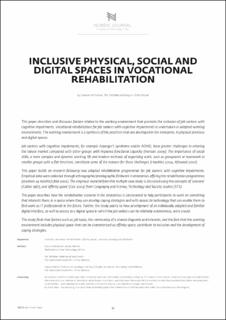| dc.contributor.author | Michelsen, Gunnar | |
| dc.contributor.author | Slettebø, Tor | |
| dc.contributor.author | Moser, Ingunn Brita | |
| dc.date.accessioned | 2024-04-08T12:02:09Z | |
| dc.date.available | 2024-04-08T12:02:09Z | |
| dc.date.created | 2019-02-14T22:39:22Z | |
| dc.date.issued | 2019 | |
| dc.identifier.citation | Nordic Journal of Science and Technology Studies. 2019, 7 (1), 32-41. | en_US |
| dc.identifier.issn | 1894-4647 | |
| dc.identifier.uri | https://hdl.handle.net/11250/3125295 | |
| dc.description.abstract | This paper describes and discusses factors related to the working environment that promote the inclusion of job seekers with cognitive impairments. Vocational rehabilitation for job seekers with cognitive impairments is undertaken in adapted working environments. The working environment is a synthesis of the practices that are developed in the enterprise, in physical premises and digital spaces.
Job seekers with cognitive impairments, for example Asperger’s syndrome and/or ADHD, have greater challenges in entering the labour market compared with other groups with impaired functional capacity (Hansen 2009). The importance of social skills, a more complex and dynamic working life and modern methods of organizing work, such as groupwork or teamwork in smaller groups with a flat structure, constitute some of the reasons for these challenges (Hawkins 2004, Attwood 2007).
This paper builds on research following two adapted rehabilitation programmes for job seekers with cognitive impairments. Empirical data were collected through ethnographic/praxiographic fieldwork in enterprises offering the rehabilitation programmes (duration 24 months) (Mol 2002). The empirical material from this multiple case study is discussed using the concepts of ‘scenario’ (Callon 1987), and ‘affinity space’ (Gee 2004) from Geography and Science, Technology and Society studies (STS).
The paper describes how the rehabilitation scenario in the enterprises is constructed to help participants to work on something that interests them, in a space where they can develop coping strategies and with access to technology that can enable them to find work as IT professionals in the future. Further, the study points to how development of an individually adapted and familiar digital interface, as well as access to a digital space in which the job seekers can be relatively autonomous, were crucial.
The study finds that factors such as job tasks, the community of a shared diagnosis and interests, and the fact that the working environment includes physical space that can be characterized as affinity space, contribute to inclusion and the development of coping strategies. | en_US |
| dc.language.iso | eng | en_US |
| dc.publisher | NTNU, Department for Interdisciplinary Studies of Culture | en_US |
| dc.rights | Navngivelse-DelPåSammeVilkår 4.0 Internasjonal | * |
| dc.rights.uri | http://creativecommons.org/licenses/by-sa/4.0/deed.no | * |
| dc.subject | praxiographic fieldwork | en_US |
| dc.subject | scenario | en_US |
| dc.subject | affinity spaces | en_US |
| dc.subject | vocational rehabilitation | en_US |
| dc.subject | inclusion | en_US |
| dc.title | Inclusive physical and digital spaces in vocational rehabilitation | en_US |
| dc.type | Peer reviewed | en_US |
| dc.type | Journal article | en_US |
| dc.description.version | publishedVersion | en_US |
| dc.source.pagenumber | 32-41 | en_US |
| dc.source.volume | 7 | en_US |
| dc.source.journal | Nordic Journal of Science and Technology Studies | en_US |
| dc.source.issue | 1 | en_US |
| dc.identifier.doi | 10.5324/njsts.v7i1.2796 | |
| dc.identifier.cristin | 1677469 | |
| cristin.ispublished | true | |
| cristin.fulltext | original | |
| cristin.qualitycode | 1 | |

